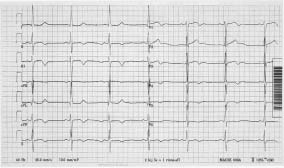Out of the frying pan and into the fire
| Author(s) | J.M. van Opstal, C.R. Hoorntje, L.M. Rodriguez | |
| NHJ edition: | 2004; 5, 234 | |
| These Rhythm Puzzles have been published in the Netherlands Heart Journal and are reproduced here under the prevailing creative commons license with permission from the publisher, Bohn Stafleu Van Loghum. | ||
| The ECG can be enlarged twice by clicking on the image and it's first enlargement | ||


A 26-year-old pregnant woman was admitted to the emergency heart department with continuous severe palpitations accompanied by chest pain which had started four hours before presentation. She had never had such palpitations before, had no medical history and was not taking any medication. A 12-lead ECG is shown in figure 1.
What is the aetiology of the tachycardia? The paper speed is as usual (25mm/s).
Answer
The ECG shows a fast, broad complex and irregular tachycardia (FBI) with a left axis. The mean cycle length of the tachycardia is approximately 200 ms, i.e. 300 beats/min. The QRS morphology changes with intermittent broad and narrow QRS complexes. The differential diagnosis of an irregular broad QRS complex tachycardia is: 1. atrial fibrillation with aberrant ventricular conduction, bundle branch block, 2. atrial fibrillation with ventricular preexcitation, and 3. polymorphic ventricular tachycardia. However, atrial fibrillation with aberrant ventricular conduction is very unlikely because of the rapidity of the tachycardia, as the AV node is not normally capable of conducting impulses at such rates in adults. The diagnosis of atrial fibrillation with preexcitation is more likely because the initiating part of the QRS complex is slow and because the polarity of the broad QRS complex fits with a right-sided posteroseptal accessory pathway.
However, (polymorphic) ventricular tachycardia can not be excluded. Because the patient was 26 weeks pregnant, no antiarrhythmic drugs were used and the arrhythmia was electrically cardioverted. The postcardioversion ECG (figure 2) shows a short PR interval and a delta wave, characteristic of Wolff-Parkinson-White syndrome (WPW). In pregnancy there is an increased propensity for the first tachyarrhythmic events to occur with WPW, because of changes in haemodynamics, hormonal function and
sympathetic tone.